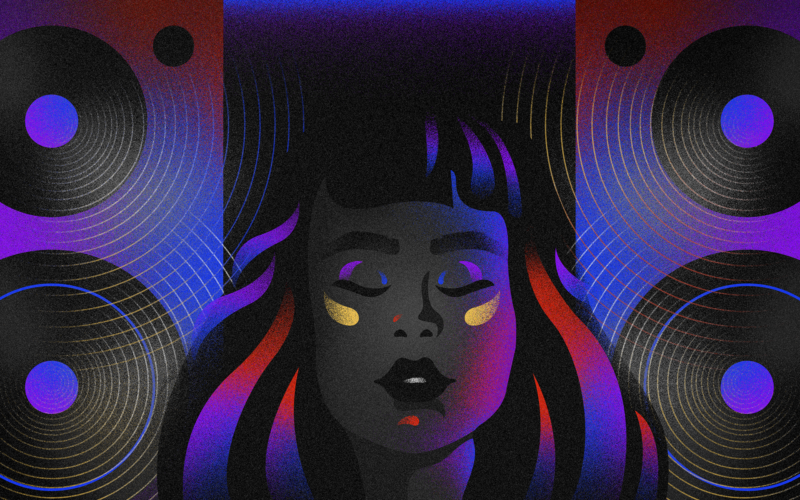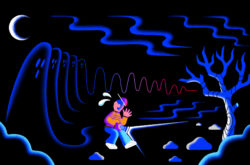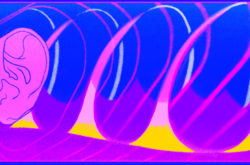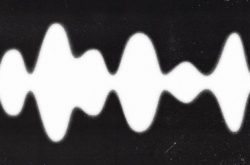Illustration: Jordan Moss
In continuing our exploration of psychoacoustics, we take a look at how precedence—the order in which we hear multiple sounds—affects our listening experience.
When exploring what the Haas effect is, let’s first take a moment to understand that any given sound we perceive creates a ‘bias.’ This bias immediately begins an associative system in the brain from which following sounds are understood in relation to what has already been heard. Our eyes do the same thing, which is why you may remember when the world viciously disagreed whether a pictured dress in 2015 was white and gold or blue and black.
Our senses are associative, constantly creating shortcuts to help us make sense of our surroundings more quickly. We naturally compare the presence of things perceived by the same senses, and understanding this can help us not only undo biases where necessary when making music, but also uncover ways to leverage audio illusions like the one we’re discussing today.
What is the Haas effect (precedence effect)?
Put simply, the Haas effect (also known as the precedence effect) is a phenomenon that occurs when a listener hears two duplicate sounds that are separated by a sufficiently short delay as a single sound event. In this case, the perceived origin of the sound will be determined almost entirely by the sound that arrives first (the bias), even if the two copies come from totally different directions.
The Haas effect: A brief history
Like the Doppler effect, the Haas effect was named after Helmut Haas following his 1949 Ph.D thesis at Göttingen University in central Germany. The centerpiece of Haas’ study was the relationship between architecture and sound, and his experiments were centered around human binaural hearing, in an attempt to better understand how we localize sound, and how our surroundings affect that ability.
Haas’ research led to the idea that through an increased understanding of how sounds bounce off of different types of surfaces and return to us as some form of an echo, architectural practices could be improved. For example, if amplified sounds exceed what’s known as a critical delay time, a pleasant reverberation, entailing a ‘’pleasant modification of the character of the tone,’’ can quickly change to an overwhelming and disorienting listener experience. This might sound fun to experiment with as a music producer (we’ll get to this below), but when it pertains to a building? Perhaps not so much.
What’s quite interesting about the exploration of these sorts of phenomena is realizing that many of these fundamental ideas were observed and documented around the same time. While the Haas effect is credited to the 1949 thesis, a study entitled ‘’On the Limit of Perceptibility of a Direct and Reflected Sound’’ holds distinct similarities to Haas’ findings. The aforementioned term ‘precedence effect’ also preceded the self-titled thesis in Hans Wallach’s work, less than a year prior and published by The American Journal of Psychology.
So, like many cases throughout history, one man’s name is now associated with what was actually the culmination of multiple published studies (and countless others not published across at least a century). In this case, it also means that the fundamentals of the Haas effect were being toyed with not more than a few years after Christian Doppler’s work. With this, we can imagine the mid-19th century as quite an exciting time to be obsessed with audio, proximity, and perception.
How to use the Haas effect in music
The Haas effect is most commonly used in music production to create a widened stereo sound out of a mono recording. If you read up on the effect across other music-making circles, there are generally a few points of consensus in terms of applying it to your music:
- The source audio must be mono, given the intended effect is to create a very specific type of widened, stereo image
- One mono track can be used with a single, stereo delay plugin
- Two identical mono tracks can be used with hard panning and a delay on one of the tracks
- Alternatively, two mono recordings with slight differences in performance can be used and panned to opposite sides without any delay
What the effect sounds like
Take, for example, this audio sample. When converted into two mono tracks, both panned left and right, with the left affected with a marginal (30ms) delay, it sounds like this:
The Haas effect demonstrated—check out the entire Vocal Psy Indian sample pack if you like the sample
While this is a simplified option to achieve the effect, remember that this phenomenon is only observed within a critical delay time. Depending on which study we reference, and the nature of the sound source, a 30 – 50 ms delay is a good place to start experimenting, as was done above. Generally, after this, you’ll start to surpass the critical delay time and begin producing a different effect than what was studied by Haas, Wallach, and countless others.
Explore more topics within the fascinating world of psychoacoustics:
October 10, 2023



